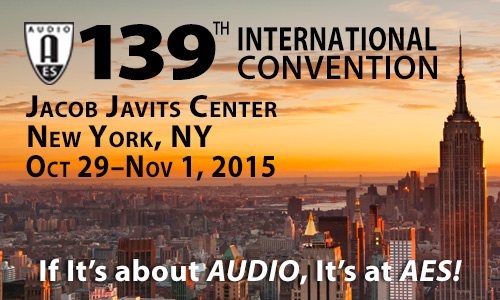AES New York 2015
Engineering Brief EB3
EB3 - Transducers—Part 2
Friday, October 30, 12:00 pm — 1:00 pm (Room 1A07)
Chair:
Michael Smithers, Dolby Laboratories - Sydney, NSW, Australia
EB3-1 Dual Filtering Technique for Speech Signal Enhancements—Mahdi Ali, Hyundai America Technical Center, Inc. - Superior Township, MI, USA
Hands free applications in automobiles, such as voice recognition and Bluetooth communications, have been one of the great features added to vehicles’ infotainment systems. However, cabin and road noises degrade audio quality and negatively impact consumers’ experience. Research has been conducted and several noise reduction techniques have been proposed. However, due to the complexity of noise environments inside and outside vehicles, the hands free sounds quality still poses an issue for consumers. This continuously existed problem requires more research in this field. This paper proposes a novel technique to reduce noise and enhance voice recognition and Bluetooth audio quality in vehicles’ hands free applications. It utilizes the dual Kalman Filtering (KF) technique to suppress noise. This method has been validated using a MATLAB/SIMULINK simulation environment, which showed improvements in noise reductions in both Gaussian and non-Gaussian environments.
Engineering Brief 209 (Download now)
EB3-2 Implementation of Segmented Circular-Arc Constant Beamwidth Transducer (CBT) Loudspeaker Arrays—D.B. (Don) Keele, Jr., DBK Associates and Labs - Bloomington, IN, USA
Circular-arc loudspeaker line arrays composed of multiple loudspeaker sources are used very frequently in loudspeaker applications to provide uniform vertical coverage [1, 2, and 4]. To simplify these arrays, the arrays may be formed using multiple straight-line segments or individual straight-line arrays. This approximation has errors because some of the speakers are now no longer located on the circular arc and exhibit a “bulge error.” This error decreases as the number of segments increase or the splay angle of an individual straight segment is decreased.
The question is: How small does the segment splay angle have to be so that the overall performance is not compromised compared to the non-segmented version of the array? Based on two simple spacing limitations that govern the upper operating frequency for each type of array, this paper shows that the bulge deviation should be no more than about one-fourth the center-to-center spacing of the sources located on each straight segment and that surprisingly, the maximum splay angle and array radius depends only on the number (N) of equally-spaced sources that are on a straight segment. As the number of sources on a segment increases, the maximum segment splay angle decreases and the required minimum array radius of curvature increases. Design guidelines are presented that allow the segmented array to have nearly the same performance as the accurate circular arc array.
Engineering Brief 210 (Download now)
EB3-3 Speech Intelligibility Advantages Using an Acoustic Beamformer Display—Durand Begault, NASA Ames Research Center - Moffet Field, CA, USA; Kaushik Sunder, NASA Ames Research Center - Moffet Field, CA, USA; San Jose State University Foundation - San Jose, CA, USA; Martine Godfroy, NASA Ames Research Center - Moffett Field, CA, USA; San Jose State University Foundation; Peter Otto, UC San Diego - La Jolla, CA, USA
A speech intelligibility test conforming to the Modified Rhyme Test of ANSI S3.2 “Method for Measuring the Intelligibility of Speech Over Communication Systems” was conducted using a prototype 12-channel acoustic beamformer system. The target speech material (signal) was identified against speech babble (noise), with calculated signal-noise ratios of 0, 5 and 10 dB. The signal was delivered at a fixed beam orientation of 135 degrees (re 90 degrees as the frontal direction of the array) and the noise at 135 (co-located) and 0 degrees (separated). A significant improvement in intelligibility from 58% to 75% was found for spatial separation for the same signal-noise ratio (0 dB). Significant effects for improved intelligibility due to spatial separation were also found for higher signal-noise ratios.
Engineering Brief 211 (Download now)
EB3-4 Designing Near-Field MVDR Acoustic Beamfomers for Voice User Interfaces—Andrew Stanford-Jason, XMOS Ltd. - Bristol, UK
We present an analysis and design recommendations for a reduced computational complexity minimum variance distortionless response(MVDR) beamforming microphone. An overview of MVDR beamforming is given then decomposed into a generalized implementation to aid mapping to a microcontroller with some discussion of optimizations for real-world performance.
Engineering Brief 212 (Download now)
